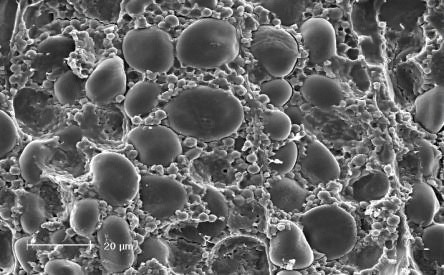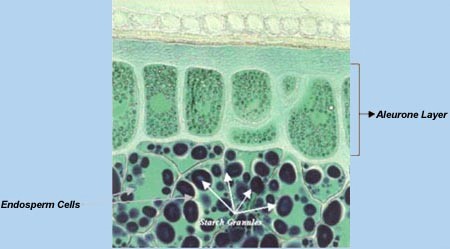

Micronisation is a process which cooks the starch in the grains thus making it more digestible for the animal. This process is called gelatinisation. The micronisation process includes firstly soaking ( steaming ) the grain and then passing it through high temperature infra-red burners and then finally rolling the grain.
This process which is similar but more efficient then steam flaking allows grain to remain partially intact but with a reduced density and increased intestinal digestion. As a result the animal will eat slower, this is especially true for horses and this slower feed intake is deemed to be beneficial in reducing the chances of colic.
The benefits of micronisation include:
IMPROVED PALATIBILITY
The micronisation process enhances the flavour of the cereals , bringing out the natural roasted taste.
IMPROVED DIGESTION
Micronisation ensures optimum gelatinisation of the starches to sugars, thus dramatically improving digestibility and therefore available metabolisable energy. This means less feed to achieve the same performance or alternatively greater performance from the same amount of feed.
PROTECTED PROTEIN
The micronisation process protects the proteins in the grain, allowing it to pass through the rumen and into the lower stomach where it can be absorbed more efficiently by the ruminants. Therefore by–pass protein is improved.
SAFE TO FEED
Because the micronisation process gelatinises the starch before it is consumed, the harmful affects of high grain feeding, such as founder, acidosis and overheating are dramatically reduced thus providing a “cool” source of energy to the animal.
Dr Nerida Richards
Traditionally, grains have been fed to horses in either a whole or cracked form. In today’s age however we are seeing grains presented to us in a multitude of ways including micronised, extruded, steam flaked or steam rolled, expanded and pelleted. As you will all be well aware, the grains contained in the Mi-Feed range of horse feeds are all cooked via a process we call micronising. The following article is going to look in some detail at micronising and why Mi-Feed uses the process to improve the feed value and safety of their feed for your horses.
Micronising is a process used to “cook” cereal grains. To cook grains via micronising, grains are moistened with steam before being passed under a series of infra-red heat lamps. This infra-red heat effectively acts like a microwave, causing the particles within the grains to vibrate and generate internal heat. Once the grains reach the desired temperature for a certain period of time they are removed from the infra-red heat sources before being rolled and then cooled and dried.
To answer this question, we need to ask ourselves, why do we feed cereal grains to our horse? Cereal grains are fed primarily as a source of energy in a horse’s diet. The energy is derived from the fibre and starch. To extract this energy, the horse must digest this fibre and starch in its gastrointestinal tract. The fibrous part of a cereal grain is fermented by bacteria in the horse’s hindgut to provide the horse with volatile fatty acids (VFAs), which it absorbs from the hindgut and burns within the body for energy. This process is the same as that used to extract energy from pasture and hay. It is efficient and will not cause digestive upsets in the horse.
In contrast, starch, which constitutes the major source of energy in a cereal grain, must be digested by enzymes in the small intestine. Starch is simply many glucose molecules all bonded together and bundled up into ‘starch granules’. These starch granules are then embedded amongst protein in a structure known as the protein matrix (Figure 1).

Figure 1: A scanning electron micrograph of the endosperm of barley showing the starch granules embedded within the protein matrix, adapted from Black (2001)
The starch granules, embedded in the protein matrix are then encased within individual “endosperm” cells and protected by a cell wall. Then many of these cells are packed tightly within the cereal grains “starchy endosperm”, which is the white stuff found in the middle of a grain. The endosperm is then protected by the aleurone layer and finally the entire structure is covered by the seed coat (Figure 2). Now from the plants perspective, all of this packaging is absolutely critical for its survival and is designed to protect the plant embryo and its stored sources of energy and protein to ensure it will be able to grow and survive for the first few days following germination.

So, the packaging is clever and essential from the plants perspective, however for the horse, all of this packaging is just a nuisance and prevents the horse from being able to digest and extract the energy from the grain. In fact, this packaging was actually specifically designed to allow a grain to pass through the gastrointestinal tract of an animal undamaged so it may germinate when it is excreted in the manure.
In order to digest the starch and extract the energy from the grain, the enzymes in the horse’s small intestine must first breech the seed coat, and then penetrate the aleurone layer. Following this they need to be able to make their way through the endosperm cell walls (these are the cells that contain the starch), then burrow through the sometimes impenetrable protein matrix before finally reaching the starch granule. Even if the enzymes are able to reach this far, it will still find that the starch is bundled so tightly into a ball that they cannot digest it. The task of an enzyme digesting the starch in an uncooked cereal grain can be likened to you breaking into a casino and stealing money from a vault … while not impossible (if you believe the heist pulled on Oceans 11), it is exceptionally difficult and unlikely to happen.
So when fed cereal grains, the horse is presented with a difficult hurdle – just how does it go about extracting the energy held in the starch of cereal grains?
It has been recognised for many years now that to effectively digest cereal grains, horses need some assistance. We provide that assistance through grain processing. Grain processing methods such as micronising are used to break down the barriers the enzymes have to face in reaching and digesting cereal grain starch.
Grain processing can take on two forms:
Physical processing is the same process as chewing and aims only to change the physical structure of the grain, breaking the seed coat and reducing the grains particle size to give the enzymes better access to the starchy endosperm within the centre of the grain. While the seed coat and aleurone layer barriers are removed, physical processing only causes minor damage to the endosperm cell walls and leaves a majority of the protein matrix and starch granule structure intact, meaning only small improvements to starch digestion will be made. Work conducted in horses showed that cracking corn only improved its digestibility in the small intestine of the horse by 1%. To markedly improve grain digestibility and give enzymes full access to the starch, we also need to disrupt the tile like structure of the protein matrix and alter the structure of the starch granule. And to achieve this, we need to cook the grain.
When grains are processed using a combination of heat, moisture and pressure, such as that used during micronising, the structure of the protein matrix is physically disrupted, compromising its ability to protect the starch granules. In addition, these processes also turn the ordered and tightly packed structure of the starch granule into an open and vulnerable structure which can be easily attacked by enzymes in a process known as gelatinisation. Once the enzymes are given free access to the starch, they can go about their work of cutting up the starch into single glucose molecules, which the horse then absorbs from the small intestine into the body, where it is burnt for energy.
Starch within grains which are fed either whole or physically processed will remain largely undigested as it passes through the small intestine and will eventually be delivered to the hindgut. This is where the trouble begins. The bacteria in the hindgut do not face the same barriers as the enzymes in the small intestine, and they are able to reach and rapidly ferment the starch contained in unprocessed or physically processed grains. This rapid fermentation of starch causes the excessive production of VFAs and lactic acid, which then accumulates in the hindgut and lowers the hindgut pH (the hindgut contents become acidic). Low pH in the horse’s hindgut causes a multitude of diseases and behavioural disturbances including laminitis/founder, colic, endotoxaemia, systemic acidosis, reduced fibre fermentation, poor appetite, wood chewing and the eating of bedding as well as deficiencies in the B-group vitamins (including biotin) and vitamin K.
The general consensus is that oats can be fed unprocessed. As it is a larger grain, horses are capable of chewing the grain enough to break its seed coat, negating the need for physical processing. Studies have also found that oat starch is far easier to digest than corn or barley starch in an uncooked form, thus negating the need for processing which will destroy the protein matrix and starch granule structures. However, whether oats can be fed unprocessed needs to be decided on a horse by horse basis. Observe your horses manure closely when you are feeding him oats. If you observe whole oat grains in his manure, whole oats is not a suitable feed for this horse. It is important to make sure the oats you are observing in the manure are whole and not just undigested hulls. Do this by taking them from the manure and squeezing them. If they are whole you will observe the white starch oozing from the centre. If you want to feed oats specifically, but your horse doesn’t digest them Mi-Feed has micronised oats available.
Don’t feed cereal grains unless they have been cooked first with the exception of oats for some horses. If you feed whole, uncooked cereal grains, your horse will get little benefit from them and they have a good chance of causing disease and behavioural problems. Remember, the reason you feed cereal grains is to provide your horse with a source of energy. Most of this energy is held within the grains starch. If the horse can’t digest this starch, then you are better off not feeding the grain at all.
Next time you go to buy feed for your horse, choose one of the feeds from Mi-Feeds range of micronised feeds. Your horse will think they taste great and you will know they are safe while still providing them with the energy they need!